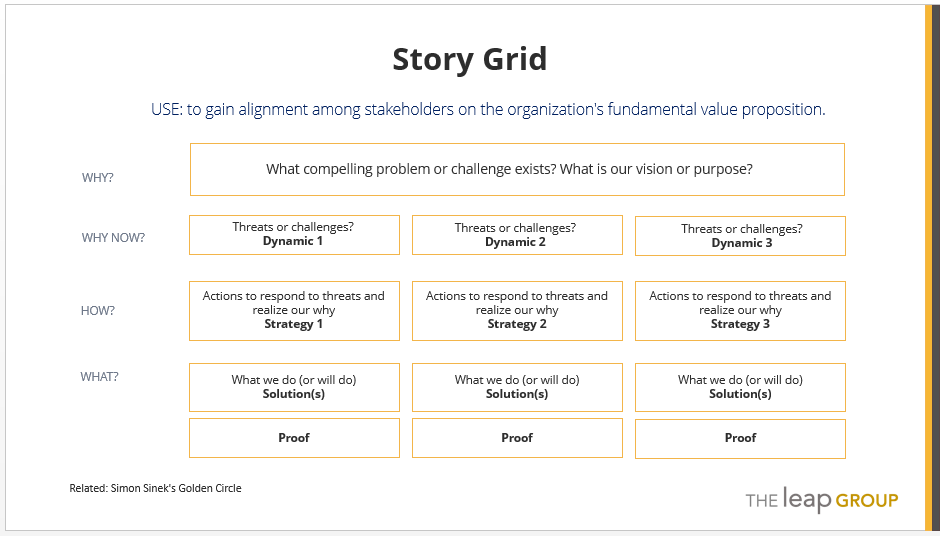“I saw the angel in the marble and carved until I set him free.” Michelangelo
Once upon a time, all you needed to create a brand was a product. That’s no longer enough. Today, every brand needs a story. How do we tell great stories? And which stories should we tell? It starts with alignment and buy-in from all stakeholders. Here is an approach that helps brand marketers, designers, and copy writers work together to find your brand story through- line.
It starts by re-thinking the messaging brief as the go-to document for creative teams.
A traditional brief summarizes the ideas essential to a pitch, a campaign, or a program: who is the target audience? What is the problem to be solved? What is compelling about the way we are solving it? What is the call to action? At best, a messaging brief synthesizes strategic decisions around markets, customers, and positioning. It can be a valuable tool for keeping marketing teams and their agencies focused, and for eliminating significant trial-and-error in executing marketing campaigns.
But challenges arise when briefs are written as a way to get stakeholders to agree on a narrative strategy or storyline. In this scenario, a classic messaging brief is simply the wrong tool, as it can quickly divert valuable energies into wordsmithing and editorializing.
If the real purpose of a brief is strategy before tactics – creating synergy and consensus among stakeholders before moving into storytelling and marketing – there is a simpler path.
Concepts before words
It’s far easier to gain consensus and alignment when people can visualize how each element of the narrative flows from top to bottom. It’s the same reason why movie makers develop storyboards. As Martin Scorsese says, “The storyboard for me is the way to visualize the whole movie in advance.”
Imagine the narrative flow, expressed in the simplest of phrases, on a one- page schematic.
Informed by the ideas of both Simon Sinek and Andy Raskin, we use a 1-page story grid with clients that starts with the why, and looks like this:
At the top: Why? What change in the world do we want to see happen? What do we collectively aspire to? Emotionally engaging stories are far more effective than factual ones.
As challenged by: Why now? What new patterns or dynamics have emerged as obstacles to this shared aspiration? This is an important insight to include, because urgency drives action.
Followed by: How? How will your organization overcome these obstacles? What is the strategic purpose behind the products and services you are delivering?
Then: What? What do your company’s products or services do to help customers capture the opportunity or overcome the obstacles depicted in the opening frames to achieve value?
Lastly: Proof. What evidence can you provide to demonstrate that what you envision is indeed possible through the solution or path you’ve presented?

The end result is packed with meaning, yet simple, structured, and easy to follow. By developing a shared understanding of the campaign narrative, everyone on the team is now prepared to tell the right story.
Different tools for different contexts
Messaging briefs, messaging platforms, message architectures (and there are many frameworks to draw from) are an excellent foundation for creating consistent, compelling marketing content. It is easier to create a messaging brief after research and data-driven decisions have been made. In other words, a brief should reflect strategy. Briefs are not the best tool for deciding upon strategy.
A 1-page story grid helps teams to think about narrative strategy in a more customer-centric way. As a visual framework, it is a great tool for teams whose value proposition is just starting to come into focus, are struggling with too many ideas, or are lost in the features and benefits.
I’ve used this approach with big companies and smaller non-profits, with executives as well as product teams. Regardless of the setting or context, the results are the same – a shared understanding of the ultimate purpose of the company, organization, or product. This always leads to quicker, more efficient messaging and story-telling.

Written By: Martha Olsen, President and Founder of The Leap Group
The Leap Group empowers technology marketers and product teams to focus on the right target audiences, create customer-centric messaging, and accelerate sales through relevant and compelling content.
Learn more at www.leapgroup.com

